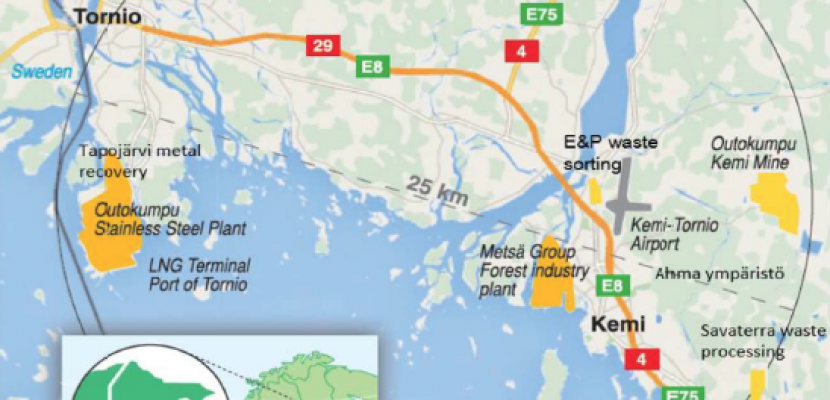Image

Kemi-Tornio Industrial Symbiosis
Published on 20 December 2018

Finland
Etelä-Suomi
This is the good practice's implementation level. It can be national, regional or local.
About this good practice
Kemi-Tornio industrial symbiosis has been developed to increase energy and resource efficiency in the region. This way, the economy of the companies involved is improved also. The symbiosis is working to:
• Joint use of utilities and firm functions
• Collective gathering and removal of waste materials
• Combining transport of goods and people
• More intensive use of space
• Public utilities with high useful effects
• Joint commercial firm facilities
• Multi-modal transport and high quality public transport .
There are plenty of industrial plants involved in the process. Biggest companies are Stora Enso Kemi and Oulu , Metsä Group (forestry industry), Outokumpu (stainless steel industy), SMA Mineral and waste management companies. In the future, also mining industry will join the activities and the symbiosis is developing gradually. Innovative service sector companies are involved in the operation by conducting research and planning to make the symbiosis function even better in practice and future.
The basic concepts of IS have been present in the Kemi–Tornio region for decades but the more systematic efforts to strengthen IS in the region commenced in the early 2000s. The initial IS cooperation is most likely company based but the development has required public support. The key actors supporting industrial symbiosis development in the region are a combination of key private companies and the regional development company, which is municipally owned.
• Joint use of utilities and firm functions
• Collective gathering and removal of waste materials
• Combining transport of goods and people
• More intensive use of space
• Public utilities with high useful effects
• Joint commercial firm facilities
• Multi-modal transport and high quality public transport .
There are plenty of industrial plants involved in the process. Biggest companies are Stora Enso Kemi and Oulu , Metsä Group (forestry industry), Outokumpu (stainless steel industy), SMA Mineral and waste management companies. In the future, also mining industry will join the activities and the symbiosis is developing gradually. Innovative service sector companies are involved in the operation by conducting research and planning to make the symbiosis function even better in practice and future.
The basic concepts of IS have been present in the Kemi–Tornio region for decades but the more systematic efforts to strengthen IS in the region commenced in the early 2000s. The initial IS cooperation is most likely company based but the development has required public support. The key actors supporting industrial symbiosis development in the region are a combination of key private companies and the regional development company, which is municipally owned.
Resources needed
Open information about the by-products, side and waste streams and other material flows between the entities operating in the symbiosis. Industrial symbiosis initiatives in Kemi–Tornio need feasibility studies, pilot activities, etc. that require public funding.
Evidence of success
There are many success stories as a results of this symbiosis:
• Promoting sustainable bio-energy resources
• Improving resource efficiency
• Access in new markets
• Sharing risks
• Opening new markets for secondary raw materials
• Reducing CO2 emissions
• Increasing profitability, revenue
• Reducing production costs
The value of IS and environmental business in the area is estimated to be at EUR 200 million annually. 1.3 million tons of industrial side streams are generated each year.
• Promoting sustainable bio-energy resources
• Improving resource efficiency
• Access in new markets
• Sharing risks
• Opening new markets for secondary raw materials
• Reducing CO2 emissions
• Increasing profitability, revenue
• Reducing production costs
The value of IS and environmental business in the area is estimated to be at EUR 200 million annually. 1.3 million tons of industrial side streams are generated each year.
Potential for learning or transfer
The Kemi-Tornio symbiosis is great example of an industry based symbiosis that can be benchmarked. This contributes to sharing knowledge between different regions in Europe. As such, this symbiosis is rather difficult to be transferred because of the nature of the industrial partners. However the symbiosis offers a learning platform for similar industries. The principles of mapping by-products and waste streams that could be utilized somewhere else and other resources to share can and should be done everywhere.
Further information
Website
Good practice owner
You can contact the good practice owner below for more detailed information.
Organisation
Digipolis, The City of Kemi, Lapland University of Applied Sciences

Finland
Etelä-Suomi
Contact
Project Manager
